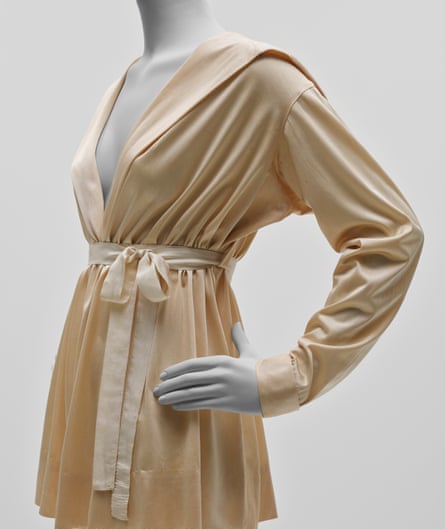The V&A’s very enjoyable exhibition Gabrielle Chanel: Fashion Manifesto kicks off with a photograph of the designer outside one of her first boutiques. At 29, she does not yet look like Coco, queen of chic: her long skirt is somewhat stodgy, her belted sweater a little lumpy. There is no glitter-flecked tweed, nor ropes of pearls. But the jut of her chin as she squints into the sunshine in Deauville, northern France, under the awning printed with her name, the hands clenched into boxer’s fists and thrust into her pockets, makes her instantly recognisable as a force of nature.
This blockbuster exhibition is first and foremost the story of a formidable woman. Born into poverty and chaos in rural France and brought up by convent nuns, Gabrielle Chanel became the architect of the modern woman’s wardrobe. Chanel’s tweed suits, little black dresses and iconic glass perfume bottles are a chic supporting cast, but there can be no overshadowing this protagonist.
We are not particularly invited to like “Mademoiselle” – a room interrogating her wartime activities points to a wily operator prepared to hedge her bets at the most fundamental of moral levels, participating in the French resistance while also working as a Nazi agent – but it would be difficult not to admire her.

There are straightforward pleasures in a show packed to the rafters with garments that modern visitors would be thrilled to wear now. Too many exhibitions of clothes can feel fussy and old-fashioned. They tend to be solemnly reverential about embroidery, breathlessly in thrall to lace-work. This one is bracingly modern. Any one of a splendid room of little black dresses – an invention that American Vogue in 1926 called “the frock that all the world will wear” – would look perfectly chic at any of this week’s London fashion week parties.
And reader, when I walked into the central atrium lined with 53 tweed suits – what Vogue called “the world’s prettiest uniform” – I’m fairly sure my pupils dilated. I spent some time trying without success to play favourites between a simple jet-black two-piece from the wardrobe of Marlene Dietrich, austere but for the braided double-C gold buttons, or a pert cream set with pockets trimmed in black, chic and charming as Chanel’s scent bottles.

The subterranean Sainsbury Gallery is an appropriately sleek setting for a show that is a love letter to modernist chic. Elegant gunmetal grey mannequins pose like cocktail party guests. Low lighting catches the gleam on their clavicles, so that they look almost real. But the challenge of this exhibition – which carries a designer price tag of £24 a ticket – is that Chanel’s understated elegance lacks fireworks. It cannot match the soaring emotion of Alexander McQueen’s Savage Beauty, nor the sugary fantasia of the Christian Dior retrospective, with its acres of cream cake-rich gowns on which to gorge.
But Gabrielle Chanel, born in 1883 and the originator of an aesthetic that looks modern 150 years later, has the main character energy to carry the story. As New Yorker writer Judith Thurman says of the success of the No 5 perfume – in Coco Chanel: Unbuttoned, a BBC film to be shown on Friday to coincide with the opening of this show – “to make a perfume that is identified for a century with allure says something about the person who invented it”.
One of the secrets of Chanel’s suits, highlighted in this show, is the gilt chain sewn into the hem of the jacket, which is there to add structure to the soft tweed silhouette by ensuring the fabric is evenly weighted around the body. There are plenty such delicious details. A letter from a 29-year-old Queen Elizabeth II to her friend, Frederick “Boy” Browning, scrawled on Windsor Castle paper, speaks to the power of Chanel. “As usual, you have discovered just the very thing I particularly wanted,” the Queen writes, “and I want to thank you very much indeed for the birthday present of the Chanel scent.”
